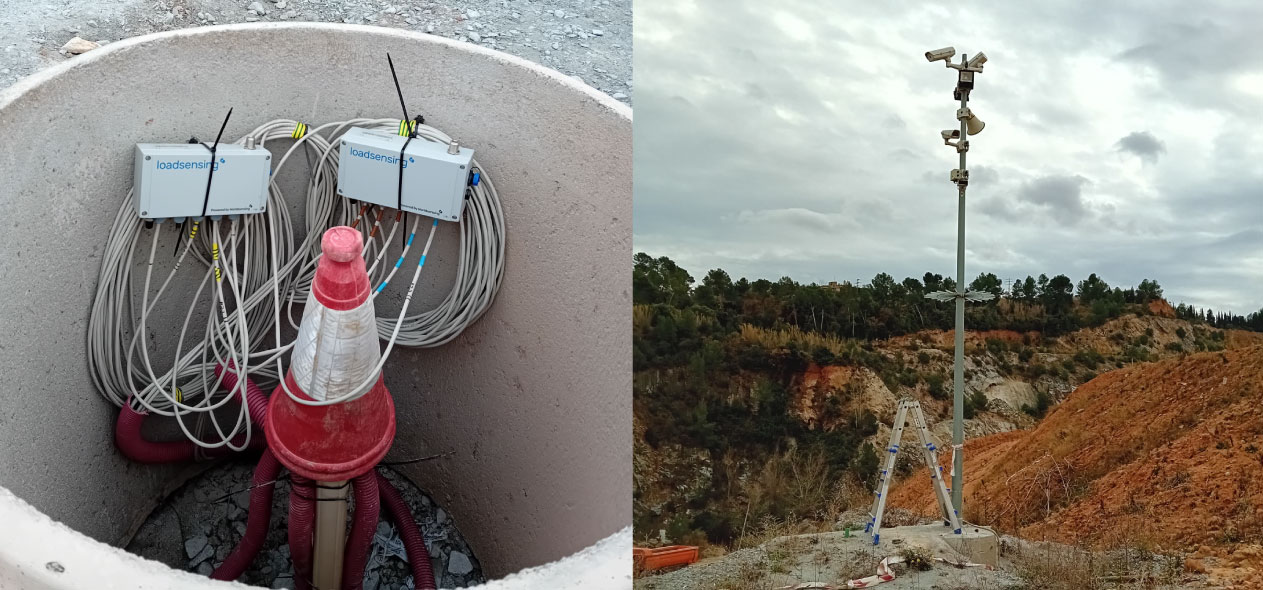Need advice?
Send us your details and we will contact you
Contact us
These activities often leave behind desolate landscapes, severe soil disturbance and loss of natural habitats. To address these effects and ensure that the recovery of ecosystems and landscapes is effective, geotechnical auscultation and instrumentation play an essential role.

Recently, SOCOTEC Spain has been in charge of implementing instrumentation techniques and carrying out geotechnical monitoring during earthworks in a restoration project of an old quarry in Barcelona. This intervention, framed within the environmental restoration actions, highlights the importance of continuous monitoring to guarantee the stability of the land and the long-term success of the project.

The environmental impact generated by the extraction of materials in a quarry is considerable. The removal of soil layers and the creation of steep slopes can generate instability in the terrain and loss of biodiversity. The restoration of a quarry involves a series of stages that seek to reverse this damage and recover the ecological functionality of the site. These stages include:
In quarry restoration, geotechnical instrumentation is a fundamental tool that allows real-time monitoring of changes in ground conditions, detecting possible movements and variations that may compromise the stability of interventions. In the Barcelona project, SOCOTEC Spain installed and monitored various types of auscultation systems, such as inclinometers and piezometers, to ensure slope stability and control groundwater conditions.


One of the main challenges in quarry restoration is the stability of the slopes, since the movement of large volumes of earth can alter the stress state of the ground. To measure these possible deformations, inclinometers were installed in the auscultation systems used , which allow detecting horizontal movements in two perpendicular directions.
The monitoring of the thrust of the ground and the evolution of the slopes by inclinometry is essential to prevent them from exceeding the maximum admissible movements foreseen during the design of the project. The monitoring of the inclinometers was carried out manually using measuring probes, ensuring exhaustive control over the stability of the ground.
One of the main challenges in quarry restoration is the stability of the slopes, since the movement of large volumes of earth can alter the stress state of the ground. To measure these possible deformations, inclinometers were installed in the auscultation systems used , which allow detecting horizontal movements in two perpendicular directions.
The monitoring of the thrust of the ground and the evolution of the slopes by inclinometry is essential to prevent them from exceeding the maximum admissible movements foreseen during the design of the project. The monitoring of the inclinometers was carried out manually using measuring probes, ensuring exhaustive control over the stability of the ground.


Another crucial aspect for the restoration and stability of the soil is the control of the water table and the monitoring of pore pressures in the subsoil. For this purpose, piezometric chains with sensors were installed at different depths, which allowed detailed information on the state of saturation of the ground to be obtained.
The piezometric sensors were connected to automatic data acquisition modules, which facilitated remote and real-time reception of the data. This system not only allowed for continuous monitoring, but also provided a solid basis for informed decision-making regarding ground conditions and possible adjustments to the restoration plan.
Another crucial aspect for the restoration and stability of the soil is the control of the water table and the monitoring of pore pressures in the subsoil. For this purpose, piezometric chains with sensors were installed at different depths, which allowed detailed information on the state of saturation of the ground to be obtained.
The piezometric sensors were connected to automatic data acquisition modules, which facilitated remote and real-time reception of the data. This system not only allowed for continuous monitoring, but also provided a solid basis for informed decision-making regarding ground conditions and possible adjustments to the restoration plan.
Geotechnical auscultation is essential to ensure the stability of restoration work in quarries. Thanks to constant monitoring and the use of advanced instrumentation, possible problems can be detected in time, such as unexpected ground movements or changes in soil saturation, which would compromise the success of the restoration.
In the case of the restoration project in Barcelona, the combination of inclinometers and piezometers made it possible to control both the physical stability of the slopes and the hydrogeological conditions of the subsoil. This ensured that the interventions carried out in the quarry were sustainable and safe in the long term.
The use of auscultation systems and geotechnical instrumentation in quarry restoration is an essential process to mitigate the risks associated with ground instability and ensure the success of environmental recovery. The ability to monitor and control changes in real-time not only contributes to the safety of operations, but also promotes the ecological resilience of the affected area.
The restoration of old quarries offers a unique opportunity to transform degraded spaces into renovated and sustainable landscapes. Thanks to the use of advanced technology, such as inclinometers and piezometers, the mining sector can move towards more responsible mining, which respects the natural environment and contributes to the well-being of nearby communities.

